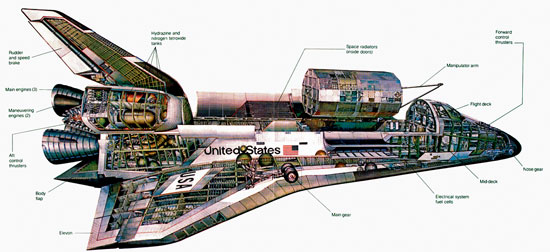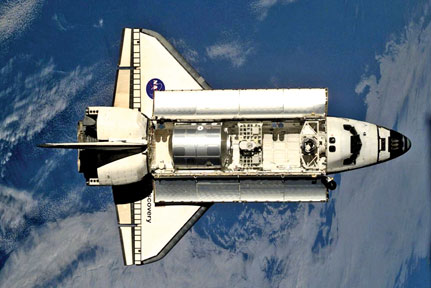 |
|
The space shuttle
Atlantis |
Space Shuttle:
The end of a cosmic journey
By Pramod DE SILVA
When it was launched nearly 30 years ago, the NASA Space Shuttle
embodied the adventurous spirit of mankind. Here was a machine which
took off like a rocket and landed like a plane. It could even piggyback
on a Boeing 747. Once in space, the shuttle was our eyes and ears to the
universe beyond. And it was the base from which astronauts 'walked' in
space to repair satellites and the space telescope. It was where we
wanted to be, among the stars, high above the Earth.
All good things come to an end, they say. And so it is with the
iconic Space Shuttle, sometimes described as the most advanced piece of
machinery ever built by man.
The space plane will be retired soon, partly due to budget
constraints (each launch alone costs more than US$ 450 million and the
total cost so far for all missions is a staggering US$ 170 billion) and
partly due to the fact NASA and all space agencies are looking beyond
orbital space flights towards the Solar System and beyond.
It will be the 'last call' for the Shuttle (Endeavour) on February
26, 2011. That will be the 134th Shuttle flight. There will be just one
more mission before that, on November 1, 2010 (Discovery).
The space shuttle saga began way before 1981, when the first test
flights were conducted using the Shuttle Enterprise from 1977 . This of
course reminded everyone of Star Trek's USS Enterprise and its bold
promise to 'boldly go where no man has gone before'.
In a way, the Shuttle was a pioneering enterprise, different from
previous space missions at the height of the Space War. Space scientists
and engineers always wanted to have a space rocket+plane that could
blast off like a rocket and land like a plane. The Shuttle answered
their prayers.
NASA is planning to send the last two Shuttles in style, farewell
songs included. The public has been invited to submit entries before
January 10 for musical performances to 'wake up' the astronauts on
board. Once the Shuttles land on terra firma, they will find homes at
several of the 21 US museums which are already battling to house them
for public exhibition. (The Smithsonian has already been promised the
Discovery). The asking price? A steep US$ 28.8 million, though this is
admittedly not anywhere near the US$ 300 million needed to buy a
passenger airliner such as the Airbus A380.
Only three space shuttles remain in active service, though Atlantis
should have flown its last mission in May this year unless a tentative
launch in June next year is approved. It is the Discovery and Endeavour
that will fly the remaining two missions. The last mission will also be
the final time that a Space Shuttle will be visiting the International
Space Station (ISS).
Although the Shuttle properly entered service in 1981, the Enterprise
never really took off into space. It was a test mule for the Shuttle
program, from 1977. The first operational flight of the Shuttle,
carrying two astronauts (Commander John Young and pilot Robert Crippen),
was on November 11, 1982, codenamed STS-1. Incidentally, the Shuttle
Columbia took off exactly 20 years after the first manned space flight -
Yuri Gagarin's Vostok 1 mission on April 12, 1961.
The launching pad for all Shuttle missions from that date was the
Kennedy Space Centre in Florida and most landings also took place there.
The Edwards Air Force Base was also used on a number of occasions. The
Challenger, Discovery and Atlantis followed in quick succession over the
next three years. It took a further seven years (1992) for the Endeavour
to enter space. Just eight years later (October 11, 2000), the Shuttle
marked the milestone of 100 flights with the launch of Discovery.
 |
|
A cross section of a
shuttle |
The Space Shuttle program had its share of triumph and tragedy. By
1986, Shuttle launches were so commonplace that the big networks did not
even bother to televise them and the public too could not care less.
Only an upstart cable TV network called the Cable News Network (CNN)
carried the launch of the Challenger live on January 28, 1986. But for
those who watched it live, what happened just 73 seconds into the launch
is forever etched in their memory. It is an indelible image, almost on
par with the horrifying pictures of 9/11.
The Challenger blew up, killing the seven astronauts on board
instantly. Among them was the first Teacher in Space Christa McAuliffe,
which added a fresh dimension to the Shuttle mission. The others were
Michael J Smith, Dick Scobee, Ronald MacNair, Ellison Onizuka, Gregory
Jarvis and Judith Resnik. The disintegration was later traced to a fault
in an O-ring seal in the right solid rocket booster and the disaster
resulted in a 32 month hiatus for the program. The first post-Challenger
mission was on September 26, 1988 (Discovery).
The next major disaster occurred on February 1, 2003, this time
during the re-entry of the Shuttle Columbia. It disintegrated over
Texas, plunging the US into shock. All seven crew members (Rick Husband,
William McCool, Michael Anderson, Ilan Ramon, Kalpana Chawla, David
Brown and Laurel Clark) died. The next Shuttle would not fly until July
25, 2005. There was an extensive investigation into the causes that led
to the Columbia's destruction. It was a sad ending to the Shuttle that
started it all in 1982.
These twin tragedies overshadow many of the Shuttle's major
achievements, including launching a number of space probes (Ex: Magellan
and Galileo in 1989) and the Hubble Space Telescope. The first US woman
in space, Sally Ride, was a member of the crew of the Challenger that
blasted off on June 18, 1983.
The first African American in space G. Bluford followed shortly
afterwards in the Challenger in August 1983. The HST was repaired on
several occasions by the Shuttle crew. The Shuttle even flew 10
classified missions for the US Department of Defence. The Shuttle docked
with the Russian Mir in 1985 for first time.
The Shuttle's biggest, though not much celebrated, contribution was
helping to assemble the ISS and keeping it replenished with crew and
supplies.
 |
|
Shuttle in space |
The Shuttle thus brought once-bitter space rivals US and Russia
together. Astronauts from a number of countries have flown aboard the
Shuttle, paving the way for greater cooperation among the international
community for space exploration. The sleek craft will be sorely missed,
in space.
NASA is launching a probe to hunt for cosmic Dark Matter during the
last Shuttle flight, underlining one of the most important aspects of
Shuttle flights - scientific studies.
Although the Alpha magnetic Spectrometer that will probe Dark Matter
is destined for the ISS, the Shuttle will be the means of conveyance.
This experiment alone is costing a massive US$ 1.5 billion, but
nothing else could have been a fitting tribute to these gentle giants of
space. Moreover, no other country except Russia had space shuttles, and
even then, it was only an unmanned craft called the Buran.
What's next for NASA and space exploration in general? The focus is
on a space vehicle that can not only supply the ISS but also travel to
the Moon and Mars carrying astronauts, by around 2020. This project,
titled Project Constellation is yet to be approved in the face of budget
cuts. The space vehicle itself will be named Orion, with room for six
astronauts.
Thousands of years hence, when Man will probably have colonised
planets in deep space (or at least Mars, for that matter), the legacy of
the Space Shuttle will serve as a reminder of our quest to find the
unknown, to explore the vast reaches of the universe and to make it our
home in the name of peace.
|

